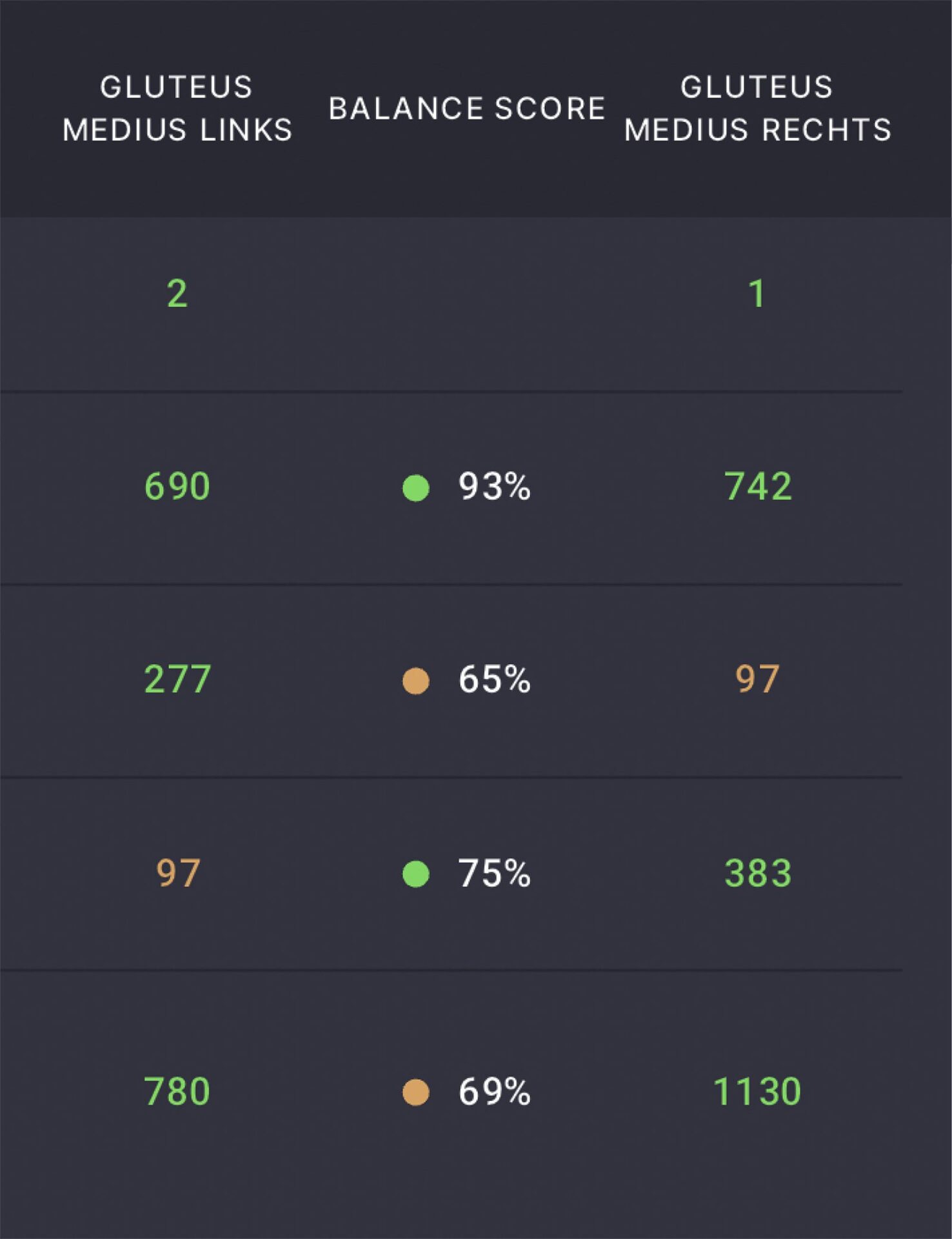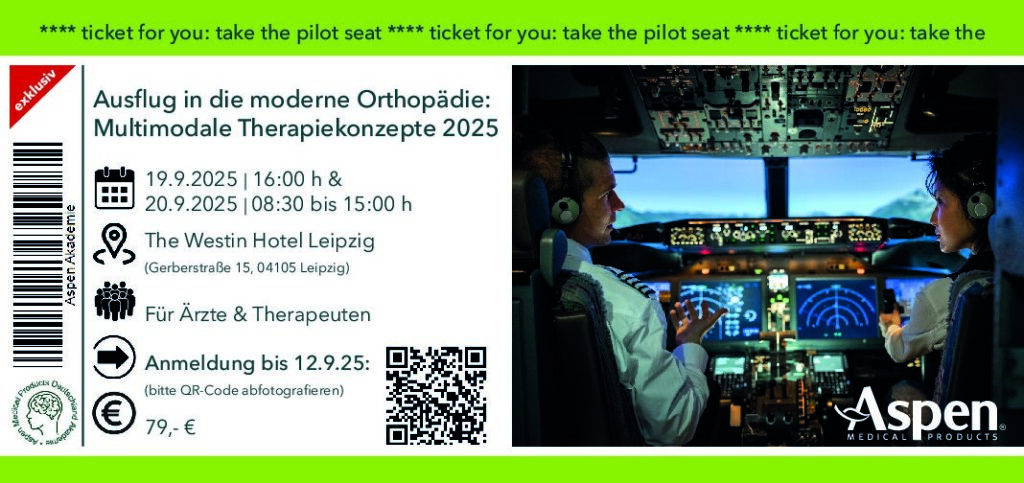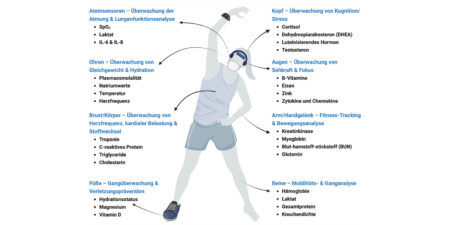While Electromyography (EMG) has been traditionally known from scientific studies or tech heavy tests in movement labs, the technology is increasingly used for rapid analysis and as a training tool in professional sports. The new era of muscle activity analysis through EMG, is based on wireless bluetooth sensors in combination with user-friendly tablet-based software solutions.
As the EMG application differs greatly in its areas of use, a general distinction has been outlined in Table 1. The use case described here addresses use cases A and B. An EMG mapping compares three activity states. The “Resting tone” is measured while standing and should not exceed a maximum activity of 15 µV (exept for pelvic floor/transversus area and the soleus muscle). If abnormalities are found, detonic measures should be considered and intensive activation can help. “Voluntary activation”, or the ability to intentionally activate a muscle, enhances an athlete’s control over their strength and can be significantly improved in just a few training sessions. “Involuntary activation” visualizes the muscle economy during movement and is mostly displayed as a balance score. High activity values reached in this test are not necessarily “good”. They may indicate weakness compensated by high effort (high activity). Therefore involuntary activity should always be interpreted in relation to resting tone and voluntary activation.

Mapping results should always lead to biofeedback training to improve both voluntary and involuntary activation. Muscle-specific strength can only be enhanced considering additional parameters such as full ROM and adjusted resistance according to the individual strength goal. Dynamic training exercises are equally important to ensure targeted and rapid muscle activation ability in sport-specific movement. This should be illustrated using the selected use case for the gluteus medius of a professional football player.
The Importance of Gluteus medius
The GM is crucial for stabilizing the pelvis and supporting the lower back, leading to improved posture (pelvic control and hip stability) and movement efficiency. Its proper function can help prevent injuries in unilateral loading situations. The analysis of EMG screenings of 48 male football players from Germany’s top three leagues revealed significant variability in the voluntary activation of the gluteus medius (average: 430 µV [± 215 µV], range: 140 – 1133 µV). Similar patterns were observed in involuntary activation (average: 449 µV [± 168 µV], range: 219 – 1116 µV), with the highest averages found among players in the first Bundesliga. These data serve as guidance and do not claim strict scientific validity.
Case: exertion-dependent hip pain
The following case study illustrates the interplay of mappings and biofeedback training sessions of the gluteus medius based on an athlete with exertion-dependent hip pain. In football, especially in the supporting leg, sagittal stability is crucial to ensure optimal performance and economy. Evaluating the neuromuscular function of the gluteus medius serves as an important parameter in this regard.
Initial gluteus medius mapping (see Fig. 2 a)
At the beginning, a standardized mapping of the gluteus medius was done with the athlete. The mapping consists of 6 exercises in total and always starts with the rest position, which in this case showed good results far below the guideline of 20 µV. The second exercise is squeezing both glutes (voluntary activation) in which the player reached a balance score of 74 % ending up slightly below the symmetry goal of 80 %.
A significant difference showed up in the unilaterally isolated activation exercises three and four. The left gluteus can be addressed «alone” and reached 119 µV at a balance score of 89 %. But the right gluteus only reached a 55 % balance score, as the left gluteus compensates when the athlete is asked to individually squeeze his right muscle.
The last exercise “one leg stands left and right” aim at the involuntary activation and have been unremarkable as they nearly reached the 400 µV guideline each side.
Biofeedback Training
In biofeedback training mode the player sees the muscle activity values of the EMG sensors in front of him on a tablet screen and visual goals in the EMG scale can be set (external focus). This setting helps the athlete to develop a basic sense of targeting his gluteus medius and is the basis to improve voluntary and “isolated” voluntary activation. The real time visual feedback enhances body awareness and the athlete`s motivation and compliance, all of which are important requirements for the exercises to come.
To transfer learnings to involuntary movements, single-leg standing with external rotation of the raised leg have been introduced. It is crucial to ensure that the athlete can control the weight. If activity decreases or stagnates with increasing additional weights, it indicates compensation by other muscles. Voluntary (isolated) activation and single-leg standing with external rotation are excellent simple exercises for home or pre-training use to enhance conscious voluntary activation of the gluteus medius. Improvements should be noticeable with the first training session, at the latest after a few days of active practice.
Targeting Tricks
Athletes can be assisted with their understanding of voluntary activation of the gluteus medius with two simple tricks. Trainers can locate the muscle and then press down with their thumb while athletes try to push it away actively. Additionally, initiating muscle contraction with external rotation of the leg during single-leg standing, can be beneficial. The gluteus medius becomes noticeably palpable at an external rotation of the lifted leg at approximately 30 degrees.
Continuous use in Athletic Training
The athletic trainer added gluteus medius exercises to the athlete’s individual training plan. Measuring activation during strength exercises ensured correct execution and enhanced exercise efficiency. For example, during a side plank, complete pelvic thrusting often increases activation by up to 200 µV, highlighting the importance of small execution adjustments. EMG also aids in identifying compensatory patterns by monitoring the activity of muscles such as the tensor fasciae latae and biceps femoris, allowing trainers/therapists to make appropriate corrections.

First phase results (Fig. 2 b)
After three weeks of intervention, the resting tone of the athlete remained stable, and voluntary activation (Squeeze Your Glutes) has been significantly improved from 100 µV to 600 µV both sides. Since strength training is limited in the competition phase, this increase is less attributed to strength gains but rather can be explained by a considerably better voluntary activation. This is also evident in isolated voluntary activation (Squeeze Your Left/Right Glute) with higher µV values and better balance scores. The involuntary exercises (One Leg Stand) also recorded higher values but an asymmetry of 69% balance score occurred, which has been addressed in the next training phase.

Re-Test in Mid-Season Screening (Fig. 2 c)
After a period without intensive EMG supervision and mapping, the presented athlete was reexamined during the team’s mid-season screening. Voluntary activation remained good but showed a left-dominant imbalance and slightly increased activity of the passive muscle on each side. These patterns may have developed due to the absence of targeted training for conscious voluntary activation. Remarkably, there was a significant decrease in the involuntary activation of the gluteus medius during the One Leg Stand on the right, returning to the value of the initial mapping (see Fig. 2 A). This highlights how quickly muscle activation can change. It can be unlearned without regular training but also rapidly improved again by targeted biofeedback training. Figure 3 shows this development over the three different measurements of the athlete for the exercise Squeeze Your Right Glute. It shows the increase after 3 weeks intervention and a slight decrease after 6 months.



Conclusion
EMG screenings provide deep insights into muscle activity and support individual diagnostics. Biofeedback training improves the muscle activation ability and assists the athlete intuitively with the efficient execution of exercises.
With the multitude of diagnostics presented to athletes, it can be challenging to stimulate their engagement and motivation. Biofeedback training, offering immediate visual feedback and showing positive changes, can have a positive supportive effect.
Successful integration of EMG into athletic routines requires user-friendly, intuitive, preferably wireless systems for flexible and effective use. The opportunity to rapidly collect and interpret data is crucial in professional sports.
Autoren
war wiss. Mitarbeiter am Lehrstuhl für Trainingswissenschaft und Sportinformatik der TU München, u. a. in den Bereichen Medizinische Datenanalyse sowie Athlete Management Systems (AMS). Seit 2021 ist er bei Eintracht Frankfurt zuständig für die Daten- und Leistungsanalyse im medizinischen Bereich.
hat Medientechnologien an der Hochschule Rhein-Main studiert, bevor er sich entschlossen hat, Physiotherapeut zu werden. Nach seinem Examen hat er sich direkt neben der Manuellen Therapie auf die Anwendung des EMG im klinischen Kontext spezialisiert. Seit über sechs Jahren implementiert er es in den Praxisalltag mit über 10.000 Messungen Erfahrung. Mit der Gründung von MYOact hat er sich u. a. auf den Leistungssport fokussiert und arbeitet mit Mannschaften aus der ersten Bundesliga und der Premier League zusammen, widmet sich aber auch der Analyse von Breitensportlern und dem „Alltagspatienten“. Außerdem ist er wiss. Beirat der sportärztezeitung.
Leitung Rehabilitation Mainz 05 Jugend Akademie.






